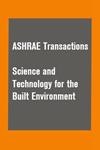热能表密度和配置对负荷分解精度影响的探讨
IF 1.7
4区 工程技术
Q3 CONSTRUCTION & BUILDING TECHNOLOGY
Science and Technology for the Built Environment
Pub Date : 2023-04-04
DOI:10.1080/23744731.2023.2197814
引用次数: 0
摘要
初始和维护成本往往阻碍了密集的亚米装置,使房间级的热能监测。先前的研究表明,建筑自动化系统(BAS)趋势数据代表了将现有的供暖和制冷仪表数据分解为设备级和系统级最终用途的未开发潜力。这些技术通过分析趋势数据来分解仪表数据,这些趋势数据提供了有关耗能设备运行状态的上下文信息。但是,为使最终用途分类成为可能所需要的分计量水平还有待研究。为此,本文利用BAS趋势数据作为预测因子,研究了亚米密度和配置对基于回归的分解策略性能的影响。该方法分为两步进行评价;首先,利用政府办公大楼建筑性能模拟(BPS)模型生成的综合仪表和BAS趋势数据,其次,利用真实办公大楼的亚仪表数据。结果突出了影响两个建筑物中安装的供暖能量亚表的最小数量的因素,以实现精确的设备级和系统级分解。本文提出的方法还可以为建筑设计规范和标准的变更提供信息,这些规范和标准涉及最小密度和分计量的适当配置。本文章由计算机程序翻译,如有差异,请以英文原文为准。
An inquiry into the effect of thermal energy meter density and configuration on load disaggregation accuracy
Initial and maintenance costs often prevent dense submeter installations that enable room-level thermal energy monitoring. Previous studies suggested that building automation system (BAS) trend data represents an untapped potential to disaggregate existing meter data for heating and cooling into device- and system-level end-uses. These techniques disaggregate meter data by analyzing trend data that provide contextual information regarding the operating status of energy-consuming equipment. However, the level of submetering required to enable end-use disaggregation has yet to be studied. To this end, this paper investigates the effect of submeter density and configuration on the performance of a regression-based disaggregation strategy using BAS trend data as predictors. The method was evaluated in two steps; first, using synthetic meter and BAS trend data generated by a building performance simulation (BPS) model of a government office building, and second, with submeter data from a real office building. The results highlight the factors affecting the minimum number of heating energy submeters needed to be installed in both buildings for accurate device- and system-level disaggregation. The methodology presented in the paper can also inform changes in building design codes and standards regarding the minimum density and appropriate configuration for submetering.
求助全文
通过发布文献求助,成功后即可免费获取论文全文。
去求助
来源期刊

Science and Technology for the Built Environment
THERMODYNAMICSCONSTRUCTION & BUILDING TECH-CONSTRUCTION & BUILDING TECHNOLOGY
CiteScore
4.30
自引率
5.30%
发文量
78
期刊介绍:
Science and Technology for the Built Environment (formerly HVAC&R Research) is ASHRAE’s archival research publication, offering comprehensive reporting of original research in science and technology related to the stationary and mobile built environment, including indoor environmental quality, thermodynamic and energy system dynamics, materials properties, refrigerants, renewable and traditional energy systems and related processes and concepts, integrated built environmental system design approaches and tools, simulation approaches and algorithms, building enclosure assemblies, and systems for minimizing and regulating space heating and cooling modes. The journal features review articles that critically assess existing literature and point out future research directions.
 求助内容:
求助内容: 应助结果提醒方式:
应助结果提醒方式:


